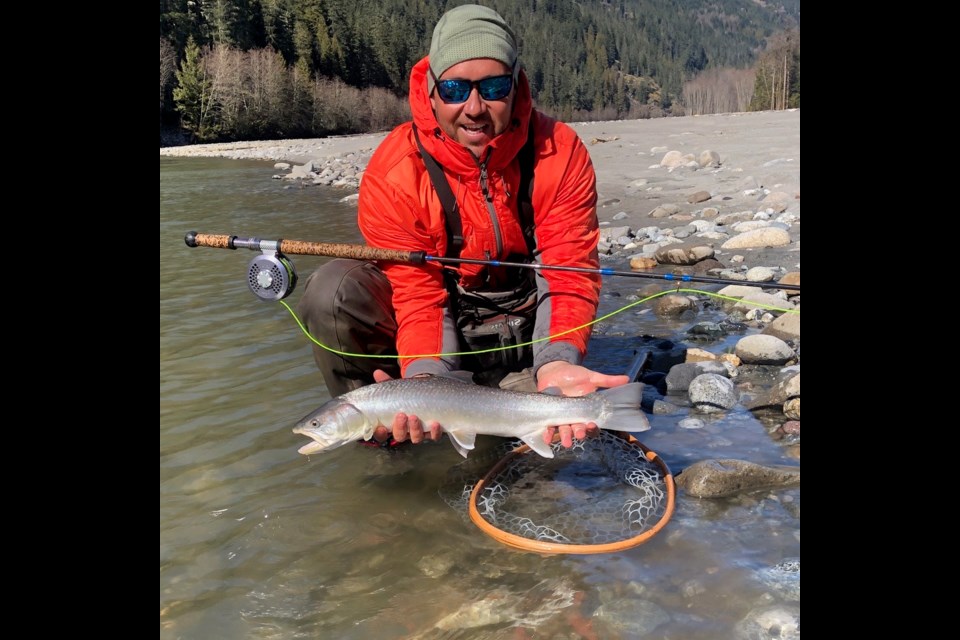Chromer Sport Fishing owner and guide Yos Gladstone has operated in the Squamish Valley for 20 years, so he knows a thing or two about the area.
It's particularly helpful being a fishing guide and enjoying the opportunity to soak in the surroundings
"One of the nice things, when you’re fishing, is everything's on a slow speed. You're not racing, you're not running a quad or an ATV and you're not driving through," Gladstone told The Chief. "You're really taking the time, so we end up getting to see all sorts of fun stuff that people don't get to see."
As backcountry visitation increases and problems start to arise, though, some projects are in the works to keep the area as pristine as possible.
The Ministry of Forests, Lands, Natural Resource Operations and Rural Development launched its Squamish River Valley Strategic Recreation Management Plan, including a public survey, in 2019 and the process is ongoing.
There are plenty of ways visitors can be respectful of the area while staying safe.
It's a special part of the world, Gladstone said, in that it's remained so wild while being so close to a populated and bustling centre in Squamish.
"It's had this way of retaining its wildness and from my personal perspective, I hope that that goes on for many, many years," he said.
One particular area that Gladstone flagged is the vast wildlife in the area, which visitors aren't always aware of or prepared for.
He noted that since Roosevelt elk from the Powell River area were reintroduced into the valley over a decade ago, there's been an uptick in predators drawn in as well.
"That's probably been the single biggest impact of anything we've seen out there," he said. "It's brought in a lot of predators because they're a good protein source for lots of other animals.
"And it's just interesting to have the biggest elk species in North America living in the backyard — and quite a few of them."
The most noticeable predator on his trail cams (which Gladstone said are set up for fun, not hunting, in areas away from human traffic and he deletes any photos a person shows up in), he said, is the coastal wolf, who are present in areas close to Squamish on the valley's west side and into Elaho and Ashlu drainages.
"They're always a treat for us to see because they move around mainly at night. We don't see a lot of wolves during the day," he said. "There are quite a few signs in the Upper Valley, of wolves, more than obviously there ever has been."
Visitors are commonly interested in bears, which are rare in Upper Valley, though some black bears are spotted throughout the year crossing the road or feeding on salmon.
The nocturnal grizzly, he added, are generally uncommon sights.
Even for an experienced guide like Gladstone, there's still the opportunity for conflict to arise. His closest encounter came along the Lower Squamish River near Brackendale.
"I was coming out one day, walking, and I was charged by a sow black bear who was bedded down with a cub," he said. "There is an increasing number of animals out there and there is an increasing number of visitors to the valley.
"So far, we've been lucky with human and animal conflicts, but certainly as visitorship goes and people are entering the valley on a regular basis, we're going to start seeing that."
Gladstone stressed that hikers and mountain bikers should be sure to make noise to alert animals to their presence, so the creatures stay away.
"With grizzlies and wolves and black bears, there could be an occasion where you find yourselves nose-to-nose with one," he said. "Remain calm, back up, make yourself present and just get out of that situation as calmly and as easily as possible."
Other advice Gladstone relayed was that visitors should create a trip plan and let people know where they're going before heading out, as there is no cell service in the area.
They should also be aware of the possibility of scents and food sources that may attract animals.
"We want people to be really mindful if they're up in the valley, even if they're just having a picnic or if they're up camping for a couple of days, that they want to secure their food source and make sure that there's no scent and no attraction for animals to come in and get a whiff of that," he said.
Gladstone credited organizations such as the Squamish Streamkeepers, Squamish River Watershed Society and the Squamish Environment Society for their good work keeping the region safe and cared for.
*Please note, this story has been corrected since it was first posted to reflect that Yos Gladstone has operated in the Squamish Valley for 20 years, not 25 as originally stated.





